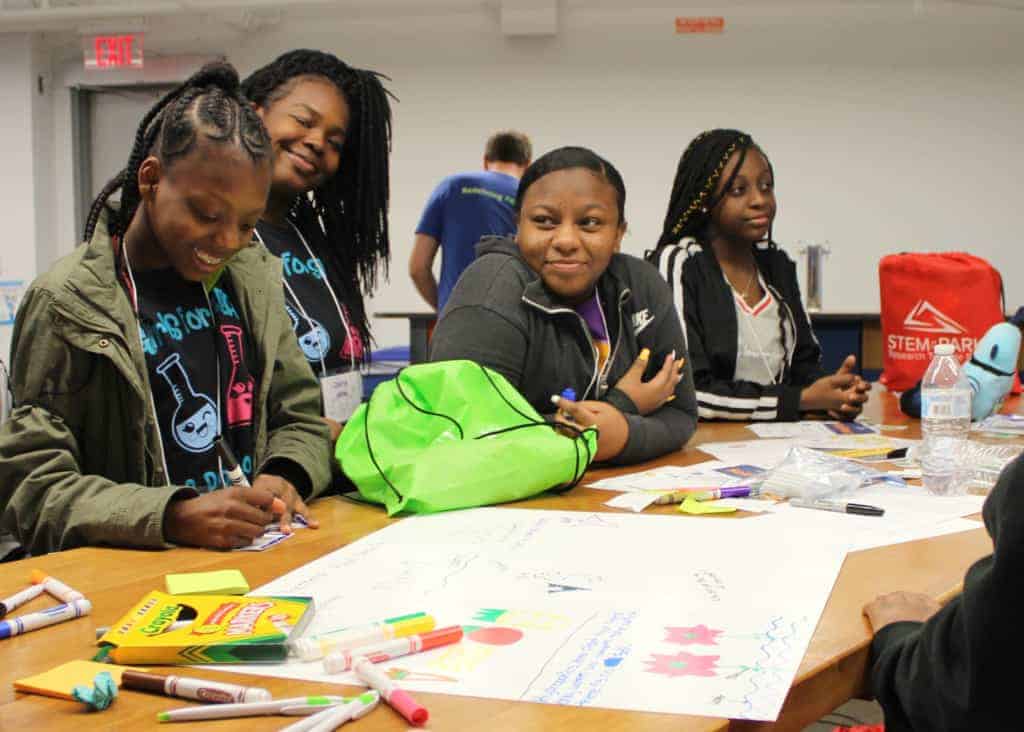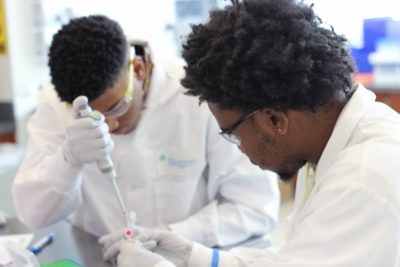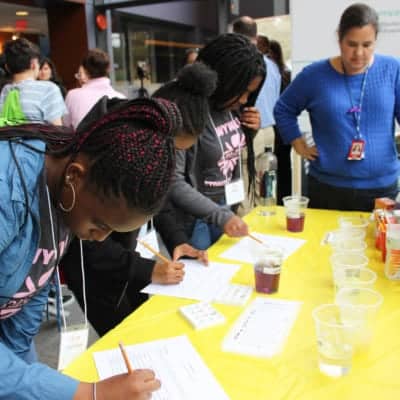
Earlier this month, 150 middle and high school students from Chatham, Edgecombe, and Wake counties joined STEM in the Park for SciFest. It was STEM in the Park’s first event as part of the North Carolina Science Festival, celebrated across the state throughout April (find an event near you here).
During SciFest, STEM in the Park Director Sarah Windsor hosted a VIP tour at RTP’s Frontier Building — taking local business leaders throughout each section of the day’s activities, broken into “Think,” “Imagine,” “Build,” and “Meet.”
For “Think,” companies like AgBiome and PSI-CRO posed a real industry challenge for students to solve. During “Imagine,” companies hosted hands-on STEM activities, and for “Build,” the N.C. Museum of Natural Sciences provided a lesson on red and white blood cell count to determine the presence of disease in primates.

Students also participated in speed mentoring by rotating through brief interviews with local scientists to learn about their careers and get advice about the field.
“We get to walk around and learn about other people’s jobs and their experience as a scientist,” said Assata’ Reid, an eighth-grader and member of Girls for STEAM at W.A. Pattillo Middle School in Tarboro.
Windsor said the goal of the meet-and-greet with STEM professionals was to show students that scientists are regular people and to have mentors share their journeys with students.
“This actually introduces them to real life,” Windsor said.
Imagine

Back in the atrium, students pored over hands-on activities, including samples of fur belonging to a lion, tiger, and jaguar at the Carolina Tiger Rescue booth. Students also viewed photographs of keepers feeding and giving medicine to the big cats.
“You don’t hear much about keeper jobs. They’re just kind of rare anyway,” said Rosemary Lively, education assistant at Carolina Tiger Rescue, based in Pittsboro. “And being a sanctuary — we’re the only federally-defined, all-cat sanctuary in North Carolina. They probably haven’t come into contact with people like us, so it’s nice to give them something different they can consider for a career.”
The Rescue also provided information to students on why tigers and other wild cats should not be kept as pets, though it is legal to own one in North Carolina.
“We have a replica skull so they can see just how dangerous these animals can be, with those teeth,” Lively said. “And then we have a ball that was in one of the animal’s enclosures … so [the students] can see the damage and how these are predators.” The deflated red rubber ball had suffered multiple punctures through tiger claw and bite marks.
“A lot of what we do requires outreach, so it is nice to be able to teach [the students] about our cause,” Lively said.

At another station hosted by the EPA (which has offices in RTP), students went through scientist gear, donning everything from hazmat suits to hardhats to protective equipment, like goggles, masks, and gloves.
“We really want the students to be able to envision themselves as scientists working for us at the EPA, and so we thought, ‘What can we bring where they can really get excited about science and see all of the actual equipment that scientists wear?'” said Chelsea Berg, environmental protection specialist.
“We are really excited that they’ve been very enthusiastically responding to this idea,” Berg said, as students posed to take photos of themselves dressed in protective gear.
Across the room, the Army Research Office offered up actual MREs (Meals, Ready-to Eat) for taste testing.
“It tastes better than it looks,” said Priscilla Bitopoulos of the U.S. Army Combat Feeding Directorate, offering a spoonful to cautious students.
But taste was only one factor that went into MREs. Bitopoulos explained that in some items, caffeine is added to help recovery and curcumin is added to help muscles and joints. There are chocolate bars fortified with calcium and vitamin D to prevent stress fractures and bone breakage, and the lemon pound cake included Omega-3s.
“There is 10% iron in this, 4% calcium, which is crazy. If you’re iron deficient, eat these,” said Catie (who requested to go by her first name), a ninth-grader at Wake Young Women’s Leadership Academy. She was reading the label on the lemon poundcake, which all students could take a package of.
Catie’s schoolmate, 10th-grader Samantha Foust, said she didn’t realize how restricted the Army is in terms of meals and how specific they have to be about ingredients.
“I didn’t know how much exactly went into it,” Foust said.
Bitopoulos said when she first joined the Army, she had no idea either about what went into their menus.
“When I first started, I was like, ‘There are people who do this? Thank goodness!'” she said. “There’s a lot of science that actually goes into the food, into the packaging. I think people just kind of think we’re arbitrarily making food.”
Tenth-grader Taylor Kerr of Wake Young Women’s Leadership Academy was impressed by the package design — some of which allowed the food to be heated through a chemical reaction — as well as making the food last for up to three years.
“It’s so innovative,” Kerr said. “They have to make these packages last for so long, and they have to make sure it’s water resistant and that air doesn’t get in the packages.”

Unlike many of the other groups hosting at STEM in the Park, Bitopoulos and her colleagues traveled from Massachusetts, and Bitopoulos said she was pleased to see such a diverse group of students, including girls.
“From a young age, I was told girls aren’t good at math or science … but the talk around it is changing,” she said. “I like that our outreach is making it all the way down here.”
Think
For “Think” sessions, students sat arranged in groups, posting ideas onto white boards and brainstorming solutions to real problems posed by companies.
At a brainstorming circle led by AgBiome, students worked on ideas for increasing food security.
“They helped us come up with ideas. At first, we didn’t really know what to talk about,” said W.A. Pattillo eighth-grader, Assata’ Reid.
“Food security is having access to healthy, nutritious food, which can be difficult especially around the world where not every place is suitable for farming and there’s a large disparity in wealth,” explained AgBiome group leader, Marie Encarnacion.
She said the students throughout the day surprised her, proposing solutions like plant protection, increasing farmland, and introducing new people to farming.

“I liked working with the different age groups and how diverse the students were,” said Encarnacion, echoing Bitopoulos. “To see kids coming in from different places, parts of the state where they’re not really exposed to science careers, I thought that was really great.”
The knowledge-sharing was appreciated not only by companies but also by students.
“As a student, it is sometimes difficult to connect what we are learning in class to real-world experiences,” said 10th-grader Caleb Williams of the Chatham School of Science and Engineering. “So coming to a place like this … we get to see what we can do and how we can go into those fields.”
Recommended reading







